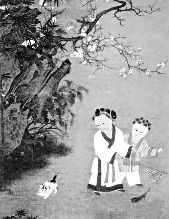One night over 900 years ago, great Chinese poet Su Shi (1037-1101) dreamed of his wife Wang Fu, who died in 1065 at the age of 27. The poet, who is best known for lines full of power and grandeur, left a particularly mournful poem that would move numerous people to tears:
"For 10 long years the living of the dead knows nought, though to my mind not brought, could the dead be forgot? Her lonely grave is far, a thousand miles away. To whom can I my grief convey? Revived even if she be, could she still know me? My face is worn with care, and frosted is my hair.
"Last night I dreamed of coming to my native place; she was making up her face before her mirror with grace. Each saw the other hushed, but from our eyes tears gushed. Can I not be heartbroken when I am awoken from her grave clad with pines, where only the moon shines!"
This poem, entitled Riverside Town, is one of five works by Su Shi included in the newly published English book Selected Poems and Pictures of the Song Dynasty.
Matching the sad poem is a painting by Su Shi, who was also known for his talents in drawing during the Northern Song Dynasty (960-1127). The handscroll with ink on paper is entitled Withered Tree and Queer Rock (Kumu Guaishi Tujuan). It is one of a few paintings by Su Shi that have been handed down to this day.
"We've tried our best to find good matches like Su Shi's poem and painting in our newly published Chinese Traditional Culture Series," said Jing Xiaomin, chief editor of the book series issued by the China Intercontinental Press this month.
The painting depicts a queer rock lying at the root of a withered tree with curled branches. Experts believe this scroll to be authentic as it was mentioned in the poems of calligrapher Mi Fu (1050-1107).
Su spent years in official circles where schemes and intrigues were a common occurrence. Together, the picture and the poem aptly express the poet's pent-up grief and indignation.
Besides the book on Song Dynasty (960-1279), there are four other books: Selected Poems and Pictures of the Tang Dynasty; Laws Divine and Human and Pictures of Deities; Verse in Three Characters and Genre Pictures; and Illustrated Book of Poetry.
All five books, which can be found at the Beijing Foreign Languages Bookstore in Wangfujing and other major bookstores in Beijing, are translated by renowned Chinese translators.
The Selected Poems and Pictures of the Song Dynasty, for instance, is the work of Xu Yuanchong, professor of literary translation with Peking University.
Xu, 84, has been widely proclaimed as a leading expert in the world in translating Chinese poetry into English and French rhyme.

The book on Tang Dynasty (618-907) is translated by Wang Yushu, 88, who taught English at the Engineering College of Shanghai University and loves Chinese and English poetry.
"Wang Yushu's son once came to us to compile a collection of his father's poetry translation as a special present for his father," said Jing, chief editor of the book series. "That's how we got the inspiration for publishing the book series. By finding relevant paintings to go with the poems, we hope to give our readers a more comprehensive understanding of Chinese culture."
During her studies of the ancient paintings, Jing found that paintings in the Song Dynasty cover a wide range of subjects and they reflect many aspects of the Chinese people's lives about 1,000 years ago.
In the early years of the Song Dynasty, the imperial government encouraged agriculture and handicraft industry growth by adopting rehabilitation policies. The prosperous society made possible the development of literature and art.
The literati came to see the art of painting in a new light. Su Shi advanced the theory of "There is painting in poetry, just as there is poetry in painting." This has become an artistic concept sought by painters and poets of later ages. It is clearly the aim of the book series on traditional Chinese culture as well.
(China Daily December 8, 2005)

